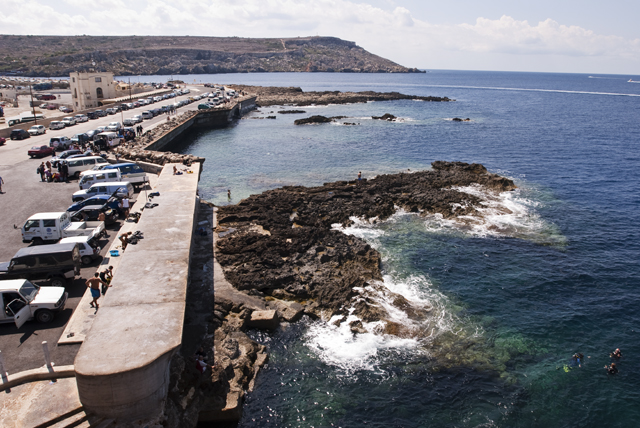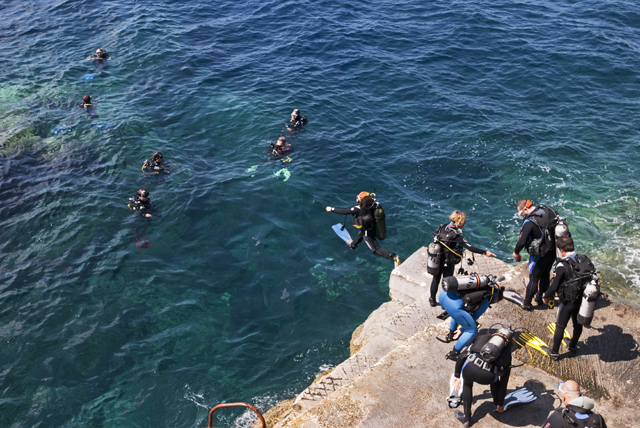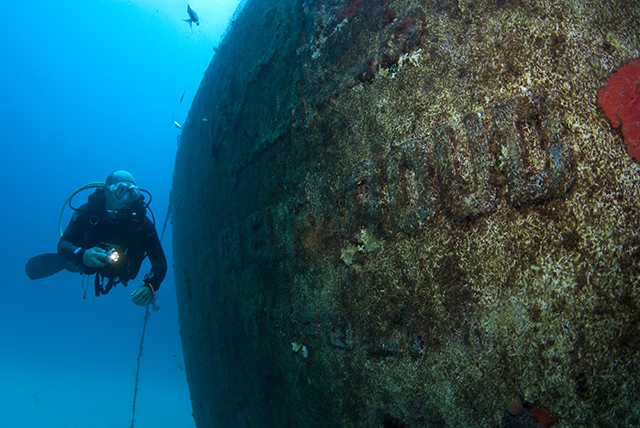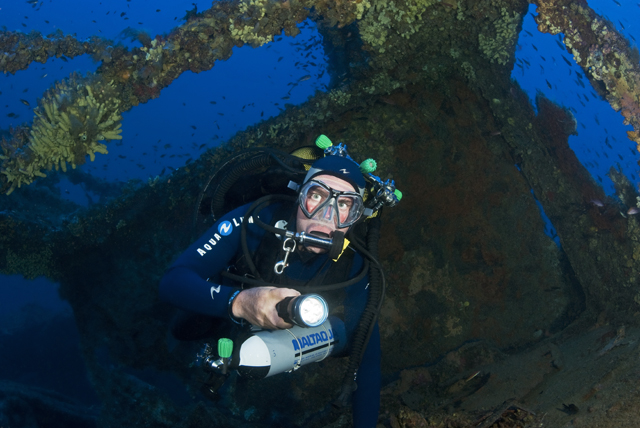News
Get wrecked in Malta
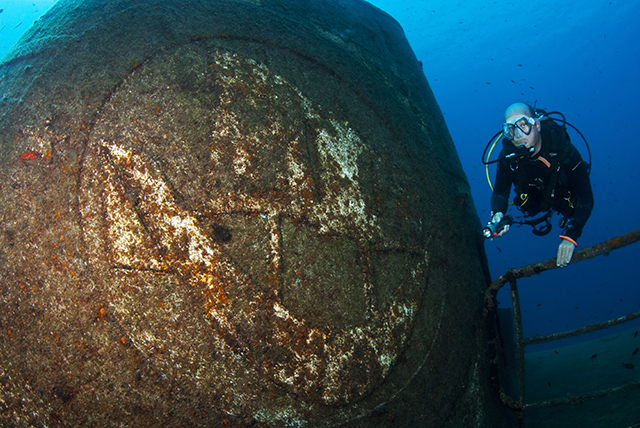
Malta offers a huge variety of wreck dives from tugs and patrol boats to WWII submarines and fighter aircraft. But with only 7-days available, where did I start? My grand plan was to begin with the popular choices and then move on to the more acquired tastes. Altogether I dived my way through 11 different wrecks at depths varying from 15 to 65 metres. Equipment and gas configurations changed dive by dive from single Nitrox 12’s to Trimix twins and sidemounts. I even squeezed in an Inspiration CCR day.
Malta is the undisputed wreck capital of Europe. Low cost flights and extremely competitive accommodation/dive packages makes the archipelago an attractive destination for Brit divers. There are more than 23 different wrecks available and a good majority are shore dives. I wanted to sample the popular sites at Cirkewwa Point and Wied iz Zurrieq as well as get a feel for the deeper offshore wrecks. I teamed up with serious Dave from Maltaqua, based at St Pauls Bay. Dave Colquhoun was the most experienced Instructor on the cards. He had been working in Malta for the past 7 years and knew his way around the roads and the dive sites extremely well. As usual the weather conditions were up and down so we re-assessed our plans on a daily basis. If it was too rough for the offshore stuff we would change tack and focus more on the protected harbour wrecks.
Cirkewwa Point has to be the busiest site in Malta. It’s not unusual to find a dozen or more dive vans parked up along the roadside. There are 2 superb wrecks, an archway and a wall dive on offer. Entries and Exits are relatively easy and there are no long walks back to the car park. Wise Dave had suggested an early start to beat the crowds. I’m sure Malta’s roads had got bumpier (or was it just the trucks hard suspension)? Drinking while on the move is not recommended. I lost most of my milkshake down the front of my t-shirt. Dave said that before the Pope’s recent visit ground workers had hastily repaired the roads but only on the prearranged route to and from the airport. It was hilarious to see one side of the road with smooth new tarmac and the other side still full of pot holes.
 Dave had chosen the more challenging giant stride entry off the concrete slipway rather than the easier wade in/wade out route. It was a good metre or two drop so I managed to pull off a triple salko followed by a double piked back somersault before hitting the water. We headed for the P29 Patrol Boat (also known as the A125) sunk as an artificial reef on the 14th Aug 2007. The 51 metre long wreck lies upright in around 35 metres of water. Before the dive Dave had asked some of the other local Instructors what the conditions were like. They warned us of a reasonably uncomfortable inshore current. It was really nice to see a friendly rapport between ‘rival’ centres.
Dave had chosen the more challenging giant stride entry off the concrete slipway rather than the easier wade in/wade out route. It was a good metre or two drop so I managed to pull off a triple salko followed by a double piked back somersault before hitting the water. We headed for the P29 Patrol Boat (also known as the A125) sunk as an artificial reef on the 14th Aug 2007. The 51 metre long wreck lies upright in around 35 metres of water. Before the dive Dave had asked some of the other local Instructors what the conditions were like. They warned us of a reasonably uncomfortable inshore current. It was really nice to see a friendly rapport between ‘rival’ centres.
I tried to take a photograph of the bow but the current had already switched direction and was now moving across the wreck. We made our way back along the deck to the bridge area. All the instrumentation panels had been pillaged. Dials, knob etc prised off. I really couldn’t understand the mentality of some divers. Later on I made a visit to the Cassar shipyard, home of the P30 (A124) sister ship. Climbing onto the bridge and going into the crew quarters, mess room, toilet etc was a real treat and gave me a totally different perspective.
 After tea and pastries we ventured over to the neighbouring MV Rozi, a 40 metre long Tugboat sitting upright at a maximum depth of 35 metres. The Rozi was sunk in 1992 as a Submarine tourist attraction but the company went bust a few years later. We made a quick detour to look at the big anchor and then headed for the Tugboat. Both of the Cirkewwa wrecks are a few minutes swim away from the entry point. There seemed to be far more fish life about. I was literally shooing bream and Chromis out the way to take a picture. Now there’s a first, I actually had too many fish in the frame. We followed the same routine, head for the bow and then the wheelhouse. The ships wheel and support pillar had long gone. A floor mounted bracket with 8 protruding screw threads was all that remained. Dave had said there was a big resident Moray so we searched the hold and around the reef floor by the stern but it was nowhere to be seen.
After tea and pastries we ventured over to the neighbouring MV Rozi, a 40 metre long Tugboat sitting upright at a maximum depth of 35 metres. The Rozi was sunk in 1992 as a Submarine tourist attraction but the company went bust a few years later. We made a quick detour to look at the big anchor and then headed for the Tugboat. Both of the Cirkewwa wrecks are a few minutes swim away from the entry point. There seemed to be far more fish life about. I was literally shooing bream and Chromis out the way to take a picture. Now there’s a first, I actually had too many fish in the frame. We followed the same routine, head for the bow and then the wheelhouse. The ships wheel and support pillar had long gone. A floor mounted bracket with 8 protruding screw threads was all that remained. Dave had said there was a big resident Moray so we searched the hold and around the reef floor by the stern but it was nowhere to be seen.
Our wreck binge continued at the small fishing village of Wied iz Zurrieq. In 1998 the 110 metre long container ship Um El Faroud was sunk as another artificial reef project. The wreck is lying upright just a few hundred metres outside the small inlet at a maximum depth of 36 metres. We kitted up on the roadside next to the cafe and then walked down a concrete pathway to the little inlet. The sea looked calm and inviting. A bunch of kids were jumping and splashing around by entry/exit ladder. We came back to the site 2 days later and conditions had changed dramatically with huge waves pounding over the sea wall. I had to dodge a number of swinging concrete blocks as I made my descent. Dave said that the weighty blocks held down the mooring lines. Instead of the using the more conventional vertical moorings the boatmen had strung them in lines across the inlet. Some clumsy divers had even head butted the concrete blocks square on.
 Dave had his own set of underwater marks to follow. Head out towards the old diving helmet plinth then follow the sand patch that looks like Casper the ghost. The prop makes an awesome wide angle shot, the oranges and reds really stood out on a blue background. Around 30-40 good sized Barracuda were milling around the stern deck. I finned past the bridge area and had a good look where the ship had ‘snapped’ in half. We decided to turn back and penetrate the bridge area. Dave coming up the stairwell made a good picture. The banister looked very similar to the one I had at home. We ascended up the funnel and then finned back to shore. Naturalist Dave stopped to show me a Seahorse camouflaged in the grass. Just to keep it even I found another Seahorse less than a metre away. The walk back up the slope was a real buttock clenching experience. Sometimes shore diving can be really hard work.
Dave had his own set of underwater marks to follow. Head out towards the old diving helmet plinth then follow the sand patch that looks like Casper the ghost. The prop makes an awesome wide angle shot, the oranges and reds really stood out on a blue background. Around 30-40 good sized Barracuda were milling around the stern deck. I finned past the bridge area and had a good look where the ship had ‘snapped’ in half. We decided to turn back and penetrate the bridge area. Dave coming up the stairwell made a good picture. The banister looked very similar to the one I had at home. We ascended up the funnel and then finned back to shore. Naturalist Dave stopped to show me a Seahorse camouflaged in the grass. Just to keep it even I found another Seahorse less than a metre away. The walk back up the slope was a real buttock clenching experience. Sometimes shore diving can be really hard work.
Long range forecasts predicted strong winds in a matter of days. While the going was good we jumped on a boat and headed out to HMS Stubborn P238, a 70 metre long S-Class Submarine sunk as a sonar target on the 30th April 1946. I wanted to get the best visibility for pictures so asked the other divers if we could be first down the line. Dave said there was rarely a current but when I reached 40 metres I could see the shot weight dragging along the seabed and rapidly heading away from the wreck. It was 50/50 decision whether to fin like crazy or abort. We only had a limited time at 55 metres and most of our gas would go just trying to reach the hull. When I spoke to Dave later he also had similar thoughts. I left the line and finned towards the dark shadow in the distance. It took us 5 long minutes but we eventually got to the Conning Tower. I managed to fire off a few pictures at an open hatchway before heading off towards the bow torpedo tubes. In no time at all we were drifting in the blue searching for the bouncing shotline. None of the other divers had reached the Submarine. As I climbed back on the boat I was acutely aware of 6 pairs of burning eyes staring right at me. I was quick to point out that I hadn’t dragged the shot line off the wreck, it wasn’t my fault, honest!
Plane wrecks are a big favourite of mine so I was really looking forward to seeing the Blenheim Bomber at a depth of 43 metres. The plane was shot down by Italian fighters on the 13th December 1941. We had a long drive over to the bay at Marsascala but once we had reached the jetty it was just a short 10 minute boat ride to the dive site. Chloe Gambin had volunteered to ‘model’ for me and it was nice to see a happy smiling face instead of Mr Serious staring back through my viewfinder.
To be honest the plane was far more broken up than I had expected and I was a quite disappointed. Dave said a lot of the deterioration had been caused by trophy hunters and boats dropping anchors or shotweights directly onto the wreckage. I still managed to get a nice picture of Chloe by the radial engine with propeller.

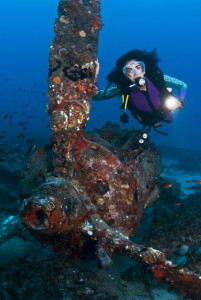 Our Boat Skipper, Pierre Spiteri, was on friendly terms with local fishermen. Whenever their nets snagged on an unknown object he would be given the co-ordinates. This had recently come up trumps with an exciting new aeroplane find at a depth of 41 metres. Pierre agreed to take us to the secret site which happened to be reasonably close to the Blenheim Bomber. I was first down the line and spotted two engines sitting side by side. One engine still had its propeller. In between there was a twisted metal framework and mass of cables but no real superstructure. I had quick scout around the debris field and there was a metal box and a cowling about 10 metres away but nothing substantial. Dave thought it could be a German JU-88 bomber, but the other divers thought otherwise. They popped into the Aviation Museum at Ta’Qali and had a chat with Frederick Galea. Frederick looked back through old newspaper clippings and found a story about a De Havilland Mosquito that crash landed off Delimara Point on the 28th March 1949. This was probably why there was no superstructure left. Mosquito’s were mostly made of wood so it must have disintegrated. He also told them the site was first discovered in 1993 by Calypso Dive Club but the co-ordinates had been lost.
Our Boat Skipper, Pierre Spiteri, was on friendly terms with local fishermen. Whenever their nets snagged on an unknown object he would be given the co-ordinates. This had recently come up trumps with an exciting new aeroplane find at a depth of 41 metres. Pierre agreed to take us to the secret site which happened to be reasonably close to the Blenheim Bomber. I was first down the line and spotted two engines sitting side by side. One engine still had its propeller. In between there was a twisted metal framework and mass of cables but no real superstructure. I had quick scout around the debris field and there was a metal box and a cowling about 10 metres away but nothing substantial. Dave thought it could be a German JU-88 bomber, but the other divers thought otherwise. They popped into the Aviation Museum at Ta’Qali and had a chat with Frederick Galea. Frederick looked back through old newspaper clippings and found a story about a De Havilland Mosquito that crash landed off Delimara Point on the 28th March 1949. This was probably why there was no superstructure left. Mosquito’s were mostly made of wood so it must have disintegrated. He also told them the site was first discovered in 1993 by Calypso Dive Club but the co-ordinates had been lost.
Lugging heavy twinsets around in a 2-metre high swell wasn’t exactly comfortable, but I was desperate for a dive on Le Polynesien. Dave and I were the only divers on Pierre’s boat which suited me fine. We were also the only 2 divers on the wreck which seemed ominous. Dave said the site was susceptible to strong currents and he wasn’t joking. I was holding on for dear life all the way down to the bow at 55 metres. Le Polynesien is a massive wreck. It would take more than a single dive to explore the 152 metre long French built passenger liner. On the 10th August 1918 she was hit by a torpedo and sank with the loss of 10 lives. I wanted to get a photo of the deck gun so Pierre suggested a visit to the bow. He actually managed to drop the shot within 10 metres of our target. The deck gun, thick with encrustation, was almost unrecognisable. I tried to get a picture on a blue background so it actually highlighted a gun shape. I also tried to get a photo of the anchor hanging from the port side but the current was far too strong. At least I had briefly experienced the wreck. Dave said that one unlucky lady had been cancelled 3 times due to adverse weather or strong currents.
 The water changed colour from deep blue to murky green inside Valetta harbour. But even though it was blowing a hoolie we still managed to keep on diving. Energetic Dave had arranged 3 more wreck dives starting off with the WWII Destroyer, HMS Maori. During an air raid in 1942 she suffered a direct hit to her engine room and sank. The ship was lifted and moved to her final resting place in 1945. Most of the wreck is now buried under tons of silt. Only the bridge area remains in view. The bow gun mount is still visible and I also found some old shells half buried underneath a rusty steel plate. There are some nice swim throughs but the structure didn’t look particularly sound. At a maximum depth of 15 metres this is a perfect wreck for less experienced divers. We even found an Octopus and a Gurnard milling about in the rocks.
The water changed colour from deep blue to murky green inside Valetta harbour. But even though it was blowing a hoolie we still managed to keep on diving. Energetic Dave had arranged 3 more wreck dives starting off with the WWII Destroyer, HMS Maori. During an air raid in 1942 she suffered a direct hit to her engine room and sank. The ship was lifted and moved to her final resting place in 1945. Most of the wreck is now buried under tons of silt. Only the bridge area remains in view. The bow gun mount is still visible and I also found some old shells half buried underneath a rusty steel plate. There are some nice swim throughs but the structure didn’t look particularly sound. At a maximum depth of 15 metres this is a perfect wreck for less experienced divers. We even found an Octopus and a Gurnard milling about in the rocks.
There was far too much to explore in just 7-days. I had only sampled a quick ‘taster’ of Malta’s wreck diving delights. I sat down with Dave before every dive and asked him to highlight 3 or 4 key areas where I could at least get one reasonable photograph. A lot of our dives were sub 30 metres so we had to consider time limitations. One of the other divers who visited the Aviation Museum was told by Frederick Galea about another aeroplane wreck that was virtually intact and as of yet un-dived at 55 metres. Watch out Malta, I’ll be back….
Gear News
Introducing the TR-80, IR-50 and CS-30 Regulators from DYNAMICNORD

Whether you are a beginner or a professional diver – with the three new main regulators from DYNAMICNORD, everyone will find their favourite regulator. They all look super stylish.
Excellent performance with the TR-80
Quality and performance are the be-all and end-all for regulators. It is not for nothing that the TR stands for Tec Reg. The innovative design of the TR-80 guarantees absolute reliability – even in ice-cold waters.

Perfect breathing effort at 0.8 J/l / certified for diving in waters below 10 degrees / structural design made of solid brass for best cold protection / membrane-compensated design with dry seal of the first stage / reduced exhalation effort thanks to optimized exhalation membrane and bubble deflector / adjustable Venturi (dive/predive) and adjustment knob for individual inhalation comfort / innovative design of the front cover prevents free-flow in strong currents or when diving with scooters / design made of sandblasted brass, matt chrome finish / 2 HP and 4 LP outlets / mouthpiece made of high-quality, anti-allergic silicone for maximum comfort.


Amazing underwater adventures with the IR-50
The IR-50 is the top regulator for advanced and experienced divers. Natural breathing is the essence of this regulator.

Ideal breathing effort at 0.8 J/l /certified for diving in waters below 10 degrees / compensated membrane / adjustable venturi (dive/predive) and adjustment knob for individual inhalation comfort/ outlet valve and deflector for minimum exhalation effort and reduction of bubbles on the face / design made of sandblasted brass, matt chrome finish / 2 HP and 4 NP outlets / mouthpiece made of high-quality, anti-allergic silicone for maximum comfort.


The Workhorse – our CS-30
For diving centres and diving beginners – the workhorse stands for strong construction, reliability and robustness. Perfect for your training.

Optimal breathing effort at 0.8 J/l /recommended for diving in waters above 10 degrees / non-compensated piston / adjustable venturi (dive/predive) / outlet valve and deflector for minimum exhalation effort and reduction of bubbles on the face / design made of sandblasted brass, matt chrome finish / 1 HP and 3 NP outlets / mouthpiece made of high-quality, anti-allergic silicone for maximum comfort.


Octopus OP-30
The OP-30 is the ideal addition to all DYNAMICNORD regulators. It is identical in construction to the CS-30.

The TR-80, IR-50, CS-30 (DIN & INT) regulators and the Octopus OP-30 are available from DYNAMICNORD dealers and in the online store.
DYNAMICNORD – Your Outdoor Companion.
Marine Life & Conservation
Paul Watson Released as Denmark Blocks Japan’s Extradition Bid

Renowned anti-whaling activist Paul Watson has been released from custody in Greenland after spending five months in detention. Denmark’s Justice Ministry rejected Japan’s request for his extradition, citing insufficient guarantees that his time already served in custody would be credited against any potential sentence.
The 74-year-old Canadian-American was arrested on July 21 in Nuuk, Greenland’s capital, when his ship docked to refuel. His arrest was based on a 2012 Japanese warrant related to a 2010 encounter in Antarctic waters. Japan alleged Watson obstructed operations and caused damage to a whaling research ship during efforts to disrupt illegal whaling. Watson has consistently denied these claims, maintaining his commitment to marine conservation.
Denmark, which oversees extradition matters for Greenland, concluded that while the legal conditions for extradition were met, the lack of assurances from Japan regarding time-served credit made extradition untenable.
In a video shared by his foundation, Watson expressed gratitude and relief, saying, “After five months, it’s good to be out… and good to know they’re not sending me to Japan.” He added that the most difficult part of his time in custody was being separated from his two young sons.
Watson is a pioneering figure in marine conservation, known for founding the Captain Paul Watson Foundation in 2022 after decades of activism with the Sea Shepherd Conservation Society. His bold efforts to defend marine life have earned him widespread support, including from celebrities and conservationists. His work has also been featured in the acclaimed reality TV series Whale Wars.
Watson’s lawyer, Jonas Christoffersen, praised the decision, stating, “We are happy and relieved that Paul Watson is now free.” He added that Watson is eager to reunite with his family and continue his vital work.
The arrest occurred while Watson’s vessel, the M/Y John Paul DeJoria, was en route to the North Pacific with a team of 26 volunteers to intercept a Japanese whaling ship. His foundation described the arrest as politically motivated and emphasized that Watson’s actions were focused on ending illegal whaling practices.
Japan resumed commercial whaling in 2019 after leaving the International Whaling Commission, asserting that whale meat is a cultural tradition. Conservationists, however, continue to challenge these practices, highlighting their impact on marine ecosystems.
Despite the challenges, Watson remains steadfast in his mission to protect marine life and bring attention to whaling practices. His dedication to ocean conservation has made him a globally respected advocate for the environment.
-

 News2 months ago
News2 months agoIconic SS United States to become the World’s Largest Artificial Reef
-

 News3 months ago
News3 months agoBook Review – 52 Assignments: Underwater Photography
-

 Gear News3 months ago
Gear News3 months agoDYNAMICNORD – New German diving brand enters the British market
-

 News3 months ago
News3 months agoExploring Cenote El Pit: A Diver’s Dream
-

 Gear News3 months ago
Gear News3 months agoTry BARE drysuits (and maybe even win one!) this Friday with Sea & Sea at North West Dive Fest
-

 Marine Life & Conservation3 months ago
Marine Life & Conservation3 months agoBook Review: Coral Triangle Cameos
-

 Blogs2 months ago
Blogs2 months agoDive the Egyptian Red Sea this Autumn with Regaldive
-

 News3 months ago
News3 months ago2024 Ocean Art Underwater Photo Competition Announced


